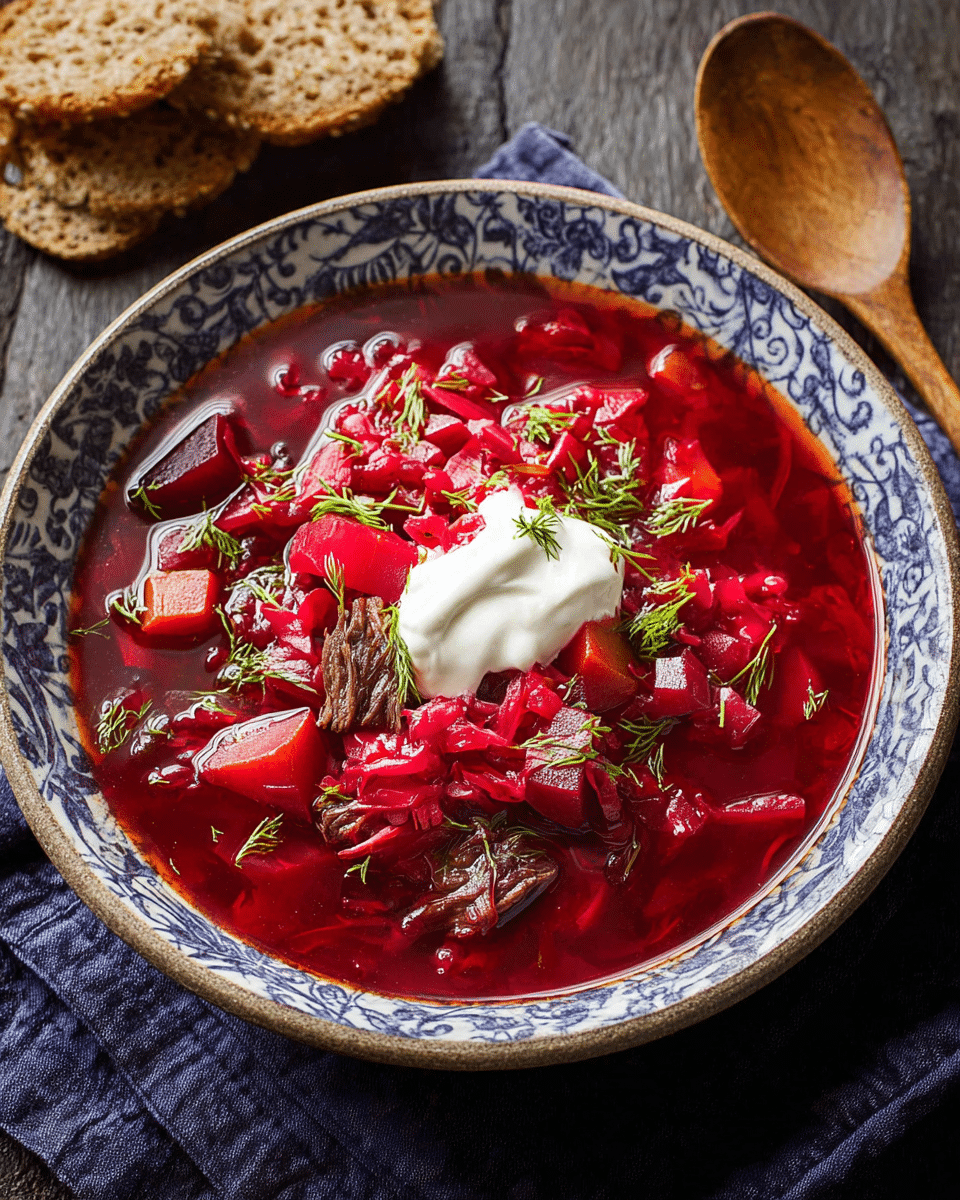Borscht is a deeply satisfying soup that blends the earthy sweetness of beets with the tang of vinegar and the richness of vegetable broth. This classic dish is not only comforting, but it’s also packed with nutrients, making it a great choice for both vegans and those who enjoy hearty, plant-based meals.
The deep red color of the soup is truly inviting, and the addition of sour cream and fresh dill adds a creamy, aromatic touch. Whether served on a chilly evening or at a family gathering, this beet borscht is bound to impress and satisfy. The balance of flavors can be customized with a splash of lemon juice for extra brightness, ensuring this dish can be made to suit your preferences perfectly.
Full Recipe:
-
2 medium beets, peeled and grated
-
1 medium onion, finely chopped
-
1 large carrot, peeled and grated
-
1 tablespoon olive oil
-
1 medium potato, peeled and diced
-
4 cups vegetable broth
-
1 tablespoon tomato paste
-
1 teaspoon sugar
-
2 tablespoons white vinegar
-
2 cloves garlic, minced
-
1 bay leaf
-
Salt and pepper to taste
-
1 tablespoon fresh dill, chopped
-
1/2 cup sour cream (for garnish)
-
1 tablespoon lemon juice (optional)
Directions:
-
In a large pot, heat olive oil over medium heat. Add the chopped onion and garlic and sauté for about 5 minutes, until softened and fragrant.
-
Add the grated beets, grated carrot, and diced potatoes to the pot. Stir well and cook for another 5 minutes, allowing the vegetables to release their flavors.
-
Stir in the tomato paste and sugar.
-
Pour in the vegetable broth and bring to a boil. Reduce the heat and let simmer for about 30 minutes, or until the vegetables are tender.
-
Add vinegar, bay leaf, salt, and pepper to taste. Continue simmering for an additional 5 minutes.
-
Remove from heat and discard the bay leaf. Stir in fresh dill and lemon juice (if using).
-
Serve hot with a dollop of sour cream on top.
Prep Time: 15 minutes | Cooking Time: 45 minutes | Total Time: 1 hour
Kcal: 170 kcal | Servings: 4 servings
The Rich History and Tradition of Borscht
Borscht is one of those iconic dishes that carries centuries of tradition and history. Originating from Eastern Europe, particularly from Ukraine, this hearty soup is beloved across Russia, Poland, and even parts of the Balkans. While many variations of borscht exist, one thing is certain: its vibrant color, earthy flavor, and comforting warmth make it a timeless dish. Whether served cold on a scorching summer day or as a warming comfort food during winter, borscht has made its mark as a staple in many households.
Borscht traditionally centers around beets, which give the soup its deep crimson hue. This vegetable, a root that has been cultivated since ancient times, was often viewed as a symbol of good fortune and health. Over time, different cultures have adapted borscht to their tastes, incorporating ingredients like potatoes, carrots, cabbage, and even beans. Its versatility makes borscht a perfect candidate for variations, allowing each cook to add their own spin on this classic recipe.
Why Borscht is So Loved
Borscht is loved not only for its bold and unique flavor profile but also for its ability to be adapted into various dietary preferences. It can easily be made vegan or vegetarian by excluding animal-based products like meat or sour cream, making it an ideal meal for a wide variety of diets. The richness of the beets and the tangy, slightly sweet taste of the broth provides a satisfying experience that is both comforting and nourishing. For those who enjoy the creamy, rich texture, a dollop of sour cream adds the perfect finishing touch.
The soup also offers a wide array of health benefits. Beets, the main ingredient, are packed with essential nutrients like folate, manganese, potassium, and iron. These minerals help to support overall health, with beets in particular being known for their heart-health benefits. The acidity from the vinegar and the balance of flavors from the dill and garlic round out the taste, creating a balanced dish that is good for both the body and the soul.
The Versatility of Borscht: Customizing the Recipe
While the traditional recipe calls for beets, potatoes, and cabbage, there is room for creativity. Some recipes add beans, while others introduce meats like beef or pork. Whether you prefer a vegan version or a more meaty one, borscht can be tailored to suit any taste. For instance, some people choose to add a touch of lemon juice for a more vibrant, citrusy kick, while others opt for a more subdued, earthy flavor by simmering the beets with bay leaves and black peppercorns. The addition of fresh herbs like dill is often considered a hallmark of a classic borscht, but you can experiment with thyme, parsley, or even tarragon for different aromatic profiles.
The texture of the soup can also be modified. Some prefer their borscht to be smooth, blending the ingredients into a velvety soup, while others enjoy it chunky with the distinct bite of vegetables. Either way, the soup remains satisfying, with each spoonful packed with flavors that deepen the longer it simmers.
Borscht in Different Cultures: A Global Perspective
Although borscht has its roots in Ukraine, it has spread far and wide across Eastern Europe, and beyond. In Russia, borscht is often served hot, garnished with a generous dollop of sour cream and sometimes accompanied by rye bread. In Poland, it’s common to find borscht served with small dumplings known as uszka, filled with mushrooms or meat. This variation adds another layer of texture and flavor to the soup.
Borscht also made its way to Jewish communities, where it became a popular dish. Jewish borscht, in particular, is often made with beets, but it’s prepared with more of a sweet and sour flavor profile. The Jewish version of borscht might also feature a bit of chicken or beef broth, but the base remains fundamentally the same. In these communities, borscht was often enjoyed as both a hot meal in the winter and a refreshing cold soup during the summer months.
In the West, particularly in the United States, borscht was embraced by Eastern European immigrants, who brought their traditions with them to new lands. Over time, borscht became a dish that was passed down through generations, with each cook adding their own modern twist to the recipe. Today, it’s not uncommon to find borscht made with store-bought broth, but the heart of the dish—its beets, vinegar, and sour cream—remains largely unchanged.
Health Benefits of Borscht
Borscht is more than just a delicious and comforting soup; it’s also a nutritious meal packed with healthy ingredients. Beets, the star of this dish, are known for their high antioxidant content, which can help fight inflammation and support the body’s immune system. Beets are also rich in nitrates, which have been linked to improved blood flow and better cardiovascular health. The addition of vegetables like carrots, potatoes, and onions increases the nutritional value, providing vitamins A and C, as well as fiber.
For those looking for a plant-based dish, borscht is a great choice. It is naturally vegan when made without animal products, and the earthy flavor of the beets can stand up to the richness of plant-based broth. Additionally, the acidity from the vinegar helps to balance the sweetness of the beets, while the addition of dill brings a fresh burst of flavor. This makes borscht an ideal soup for both vegans and omnivores alike.
Pairing Borscht: What to Serve With It
Borscht is a meal on its own, but it can also be paired with a variety of sides to enhance the dining experience. A slice of fresh rye or whole-grain bread is a traditional accompaniment to this dish, perfect for dipping into the soup. The bread’s dense texture complements the soup’s richness, while its flavor balances the tangy notes of the borscht.
Another popular side is a serving of pirozhki or pierogi, which are small, savory pastries filled with fillings like potatoes, meat, or cabbage. These dumplings are often served alongside borscht for an added layer of indulgence.
For a lighter meal, a simple side salad made with fresh greens and a light vinaigrette can help cut through the richness of the soup. The acidity in the salad will complement the vinegar in the borscht, creating a perfect harmony of flavors. You might also consider serving borscht with a dollop of sour cream or a drizzle of olive oil, both of which add creaminess and texture to the dish.
Serving Borscht: Hot or Cold?
One of the great things about borscht is that it can be enjoyed both hot and cold. Traditionally, borscht is served hot, especially in colder climates where a warm, hearty meal is essential for comfort. However, in many regions, borscht is also served cold, especially in the summer months. Cold borscht is refreshing, with the vinegar adding a tangy kick that makes it perfect for hot days. Cold borscht is often served with a garnish of hard-boiled eggs and fresh dill, and sometimes a side of rye bread.
No matter the season, borscht can be enjoyed year-round, and its versatility in temperature and serving style only adds to its charm.
Conclusion: A Dish with Heart and Soul
Borscht is much more than just a soup—it’s a dish with history, tradition, and deep cultural significance. Its simple ingredients come together in a way that is both comforting and nourishing, and its flavor profile, which balances sweetness, acidity, and earthiness, appeals to a wide range of palates. Whether you enjoy it hot or cold, with meat or vegan, borscht remains a dish that brings people together.
By making borscht at home, you’re not just preparing a meal—you’re partaking in a centuries-old culinary tradition that has been passed down through generations. With its vibrant color, rich flavor, and health benefits, borscht is truly a dish worth celebrating.
No matter your background or dietary preferences, borscht offers something for everyone. Whether enjoyed on a chilly winter’s evening or as a refreshing summer treat, this classic soup will undoubtedly remain a beloved part of global cuisine for years to come.






